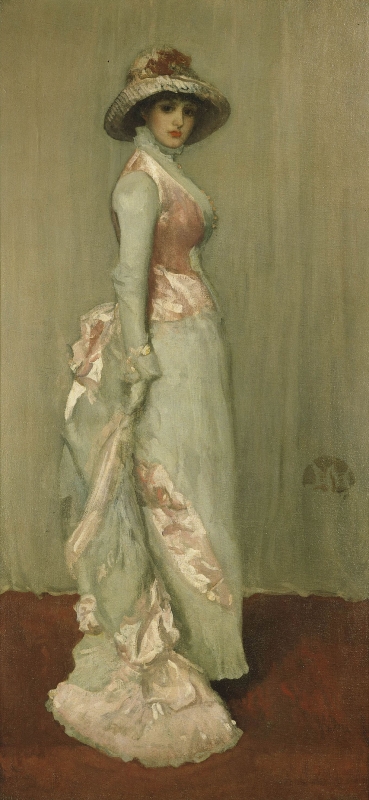Composition
A pen drawing, Harmony in Flesh Colour and Pink [M.0852] shows her with her arm slightly bent, her figure more curved, and the brim of her hat much smaller. It is possible that this drawing was done after the painting was exhibited in 1882 (it has a butterfly that may date from 1882/1884) and the pose and dress were altered in response to criticisms of the oil. 1
Technique
It is painted on very coarse canvas. The St James's Gazette commented on 21 March 1892 that the canvas was 'wide-meshed, and might have provided material for sifting sand' but added that it was 'by no means ill-adapted to the ends obtained.'
Her face is painted quite thickly, but so thoroughly worked that it has a fine matt surface. It has a sultry glow, which is set off by the thinner paint of her glossy bodice. Taylor notes that Whistler painted with 'bold, broad crisscross strokes' on the ruffles, and 'short, racy touches' on her hat. 2 The hat originally extended further right. A horizontal line of paint seems to cross under the foot of her train, as if a carpet or stairs were originally drawn there. Taylor observes that another butterfly was originally painted several inches lower than the present one, and this is seen in an early photograph of the portrait. 3
Walter Richard Sickert (1860-1942) instructed viewers in 1892:
'Look at the revel of the brush on the coarse threads of the portrait of Lady Meux. Is it not beautiful and exhilarating in itself, and is it not a marvel how … the gown is built up by passages of brushwork, which in no way copy the dress, but express it in a language of inspiration?' 4
A visual examination by Professor Joyce H. Townsend, conservator, Tate Britain, records that there is a quite bright pink imprimatura, and that overall the paint is not much thinned, and is quite opaque in appearance. The face in particular, and the gloved hand, are highly finished, and the crown of the hat has been lowered. The butterfly was added when the picture was dry.
Conservation History
In November 1891 Lady Meux suggested the painting should be taken away and 'I think it would be as well if you were to varnish it.' 5
The painting was accordingly sent to Stephen Richards (1844-1900), picture restorer, in Berners Street, where Whistler urged Théodore Roussel (1847-1926) to see 'un certain portrait de Lady Meux', and likewise urged Robert de Montesquiou-Fezensac (1855-1921) to see 'the Pink Lady-Meux'. 6
The Frick Collection conservation records state that blooming was noted when the painting was at Knoedler’s gallery in 1933; and in 1938 George L. Stout noted skewed canvas threads (the threads being pulled higher on the left side), and that it had been cut down on the left side, so that there was ca 80 mm of painted canvas on the reverse of the stretcher; he also stated that the ground was white and thin. In 1941 William Suhr noted yellowed varnish and dirt; he did not treat it then but in 1943 he removed the varnish and applied a new varnish. The surface was cleaned in 1980 by John Brealey. 7
Frame
1882: It is possible that it was originally framed in the reeded cassetta frame that is now on Arrangement in Brown and Black: Portrait of Miss Rosa Corder [YMSM 203]; that frame has an autograph handwritten label on the verso reading ‘Pink Picture – J Whistler – 13. Tite Street - Chelsea’. Whistler took a studio at that address on 22 March 1881. Harmony in Pink and Grey: Portrait of Lady Meux [YMSM 229] was painted in the Tite Street Studio and first exhibited in 1882. 8
The label suggests that at a later date the frames of Arrangement in Brown and Black: Portrait of Miss Rosa Corder [YMSM 203] and Harmony in Pink and Grey: Portrait of Lady Meux [YMSM 229] were switched. This could have been when both were shown in the 1892 Goupil exhibition.
1892: After Harmony in Pink and Grey: Portrait of Lady Meux [YMSM 229] was exhibited in Whistler's retrospective exhibition in 1892, Lady Meux complained that 'last time the frame of the picture was so damaged that I had to have it reframed, I mean the pink picture.' 9 The style and whereabouts of the replacement frame are unknown.
ca 1910: The current Portrait Whistler frame is American-made and dates from the early 20th century. It could have been made when the picture was bought by Henry Clay Frick (1849-1919), or after 1919 when it entered the Frick Collection. 10
Notes:
1: MacDonald 1995 (cat. rais.) [more] (cat. no. 229).
2: Taylor 1978 [more] , p. 123.
3: Photograph, LC PC.
4: W. Sickert 1892 [more] ; W. Sickert 2000 [more] , p. 93; Robins 2007 [more] , p. 161.
5: Lady Meux to Whistler, 28 November 1891, GUW #04070.
6: To Roussel, [31 December 1891], GUW #13426; to Montesquiou, [December 1891], GUW #13617.
7: Annotated notes by Dr (now Professor) Joyce Townsend, Tate Britain, May 2017.
8: Dr Sarah L. Parkerson Day, Report on frames, 2017. See also Parkerson 2007 [more] .
9: V. B. Meux to Whistler, 2 December 1892, GUW #04075.
10: Parkerson 2007, op. cit.
Last updated: 31st December 2020 by Margaret








